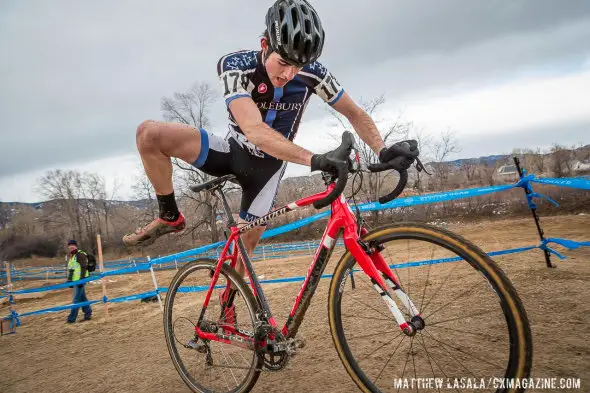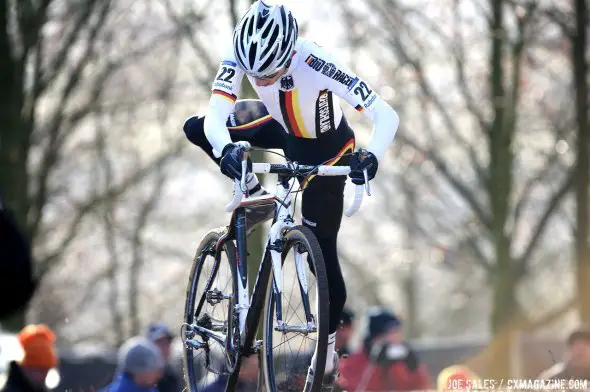With many of us pulling out our cyclocross bikes and practicing barriers and remounts (and maybe even preparing for dropped chains) for the first time in months, this is the perfect time of year to reintroduce this article about groin injuries from our beloved, humble Issue 1. As well as preventative tips to help you avoid sprains and strains, this also offers remedies in the event of a mid-season injury.
Pay special attention to some of the static stretches near the end. These work far better when implemented regularly throughout the course of the week rather than the minutes before a race, which can sometimes do more harm than good.

Sam O’Keefe shows how the groin is used, and be strained, during a remount (D2 Collegiate Men’s race at the 2014 National Cyclocross Championships). © Matt Lasala
The start of the cyclocross season offers new challenges to any rider, whether they have already been racing the road or on mountain bikes, or they transition right from the couch to the race course.
Remounting on a cyclocross bike brings into play a whole new set of mechanics that racers must once again master. Mounts, dismounts, barriers, and adverse weather conditions are common components of cyclocross and can lead to some very unique cycling injuries.
Straining the adductor muscles, commonly referred to as the groin, is a painful way to end your season, and the sport of cyclocross can have a high rate of groin injury. When you pull or strain your groin you have overstretched and caused small tears in your adductor muscles, which span from the inner pelvis down the inner parts of your thighs and attach primarily at the knee. They are concerned with pulling or maintaining your legs toward the midline of your body and also act to help stabilize the hip joint.

Phillip Walsleben (GDR) shows how to remount without jumping, but you need a flexible, strong groin and hip flexors (2009 Worlds). © Joe Sales
In cyclocross, these muscles come into play every time you mount and dismount your bike. Swinging your leg around the saddle is a potential stressor to the area and can cause overstretching and strain to the groin muscles. This is especially true early in the season when our technique is not as refined as it should be. We jump a little higher to avoid hitting our privates, push off a little harder with the back foot to gain extra speed, and our body is not accustomed to these explosive, awkward motions. An injury of this type can also be caused by running uphill barriers, abruptly changing direction while running or managing a change in terrain.
Your previous injury history, athletic background and the amount of cyclocross training you do all play a role in deciding which of the above mechanisms may affect you (and your groin). When you have a sore groin, it is important to take steps to prevent this acute condition from becoming chronic. Anyone who has had a serious groin pull can tell you how debilitating this injury can be. Much like back pain, you can feel it during nearly all motions.
Grades of Injury
Groin strains are like any other muscle strain and are graded dependent on the severity of the injury.
A grade I typically presents with mild soreness, no real strength loss or swelling. Riders are usually able to continue riding and running. This is a result of micro tears in the fibers of your adductor muscles.
A grade II is a partial tear of the affected muscle(s) and can present with moderate soreness and muscle weakness. A limitation of more strenuous activities such as running hills and mounting your bike is common.
A grade III is marked by significant bruising, swelling and pain with nearly all motions. A moderate amount of muscle weakness is also present. The cause of this type of strain is the result of applying a significant force through the muscle which causes a complete rupture from the bone. If this occurs, stop any physical activity (you likely won’t have the desire to continue anyway) and consult your primary care physician.
My Groin Hurts, Now What?
Warm It Up: Muscles respond best to stretch when tissues are warm. Performing an active warm up on a stationary trainer or riding the flats prior to a race or ride will elevate tissue temperature and stimulate blood flow, both of which will allow muscle tissue to become more elastic. Applying a hot pack prior to stretching or riding is also an option.
Stretching: Gentle stretching to the area is considered necessary to maintain elasticity thereby regulating any muscle imbalances that can occur. The best way to stretch muscle tissue is gradually over time, avoid performing quick jerky stretches that can increase your symptoms. Use pain and soreness as a guide. Always perform a prolonged stretch of moderate intensity (3 repetitions of 30 seconds). See pictures in the next page as a guide.
Recent studies have shown a decrease in muscular strength and force production and possibly stability when the muscles are stretched greater than 20% of their resting length. My suggestion: perform stretches of low to moderately low intensity prior to an event with the aim of working the involved muscle through its normal range of motion. Dynamic stretching, which also avoids jerking motions, can be more beneficial directly prior to a race than static stretching. With larger grade strains, you may want to seriously reconsider racing until you’re better rested.
Ice: If you experience a strain in your groin during riding or wake with a sore groin, apply ice to the area especially within the first 48 hours. Ice helps calm any inflammation and later stimulates blood flow, both of which are needed.
Rest: Regardless of the severity of strain, rest is indicated to allow the body time to heal. This is obvious, yet we all know how athletes dislike resting. In the end it will allow you to recover quicker and may stave off future chronic groin strains.




























